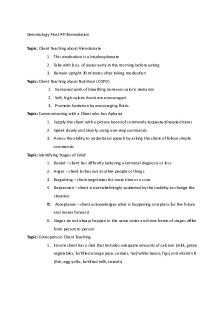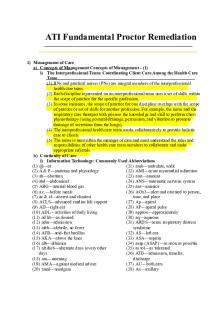ATI Remediation - Info given after test taken. PDF

| Title | ATI Remediation - Info given after test taken. |
|---|---|
| Author | Oak Lane |
| Course | Child and family |
| Institution | Concordia University Texas |
| Pages | 3 |
| File Size | 76.9 KB |
| File Type | |
| Total Downloads | 81 |
| Total Views | 137 |
Summary
Info given after test taken....
Description
Form A & B Remediation Form A Abuse/Neglect: Psychosocial Issues of Infants, Children, and Adolescents: Identifying suggestive Manifestations of maltreatment The ill-treatment of infants and children is contributed to a wide variety of things, parental background upbringing, economics, educational background, and environmental surroundings. o Manifestations Physical: bruises/welts (in various stages), burns, fractures Emotional: failure to thrive, sleep disturbances, withdrawal Sexual: bleeding of genitalia/anus/mouth, UTI, regressive behaviors Shaken baby syndrome or Abusive head trauma: vomiting, respiratory distress, bulging fontanels Medication Admin: Immunizations: Determining possible contraindications The point of vaccines are to aid in keeping down communicable diseases and building immunity. o Contraindications Severe allergic reactions (anaphylaxis) Moderated or severe illnesses with or without fever Do not admin live virus to children who are immunocompromised (varicella, MMR) Laboratory Values: Hematologic Disorders: Interpreting Lab Values Iron deficiency anemia o CBC: ↓RBC, Hgb, and Hct; Iron: elevated Sickle cell anemia o CBC: determine anemia; sickle-turbidity: screening tool for HbS; Hgb electrophoresis: Separates various forms of Hgb o Sickle-cell crisis: ↓Hgb, ↑WBC, ↑bili and reticulocyte Hemophilia o aPTT, factor-specific assays (deficiency), platelets and PT (WNL) Alteration in body systems: Skin infections and infestations: Providing teaching to an Adolescent who has Tinea Pedis Take medication provided (oral griseofulvin, topical tolnaftate) Wear light-colored socks, well-ventilated Wash hands well Pathophysiology: Chronic Neuromusculoskeletal Disorders: Assessment of Spastic Cerebral Palsy CP is impairment to motor function especially motor control, coordination, and posture that is nonprogressive. o Spastic CP (pyramidal) Hypertonicity (muscle tightness or spasticity), ↑DTR, clonus, and poor control of motion, balance and posture. Impairment is fine & gross motor skills Can present in all four extremities (tetraplegia), one limb, one side of the body or LE.
Form A & B Remediation Form B Adverse effects, interactions, and contraindications: Priority treatment of Anaphylaxis
A life-threatening, immediate allergic reaction that causes respiratory distress, severe bronchospasm, laryngeal edema, a quick drop in blood pressure, as well as cardiovascular collapse. o NURSING CONSIDERATIONS: Epinephrine Bronchodilator Antihistamines
Growth hormone deficiency: medication management
GH’s are needed for the growth, development and cellular metabolism of the body. Hormones such as ACTH, TSH, FSH and LH work with GH to control the metabolic process in the body. When there is a deficiency of the GH Hypopituitarism if suspected and replacements are given. o Management of GH Measuring Height and weight and compared of a growth chart every visit Check for the effectiveness of the GH replacement Give support to family and child pertaining to the body image, possible depression and psychosocial.
Head injury: Manifestation of Increased Intracranial Pressure
Head injury occurs when there is a traumatic injury to the brain and changes the way the brain works. We can see sings and symptoms of ICP in three ways, minor, progressive and severe. o Increased Intracranial Pressure Minor Loss of consciousness A period of temporary confusion Vomiting Progressive VS changes AMS Neurological deficits Sever Infants: swollen fontanels, separation of sutures and irritability Children: forceful vomiting, headaches, and increased sleeping
Acute Neurological Disorders: Analyzing Spinal Fluid
There are tests that are done to analyze spinal fluid to check for Meningitis in children. o Laboratory Values Blood cultures- will show + at time when CSF if -. CBC CSF collection
Form A & B Remediation
Bacterial: cloudy color, ↑WBC count, ↑protein content, ↓ glucose content and + Gram stain. Viral: clear color, slightly ↑WBC, normal to slightly ↑ protein content, normal glucose and – Gram stain.
Cardiovascular Disorders: Care of an Infant during a Hypercyanotic spell
Due to congenital or acquired heart disease, heart failure can arise. Major defects the cause a decrease in pulmonary blood flow, such as Tricuspid atresia, and Tetralogy of Fallot. What these conditions do is cause heart failure that does not provide adequate blood supply to meet the bodies needs. o Care for Hypercyanotic spells Knees-to-chest Surgical shunt Surgical repair (Glenn, Fontan)
Cardiovascular Disorders: Manifestations of Kawasaki disease
Kawasaki disease is another cardiovascular disorder that is an acute systemic vasculitis, which means blood vessels become inflamed throughout the body. o Manifestations Fever greater longer than five days and not affected by medications Red eyes, lips, tongue (strawberry), oral mucous, palms and soles of the feet Nonblistering rash
Gastrointestinal Structural and Inflammatory Disorders: Manifestations of Intussusception
A condition where a segment of the bowel telescopes into another portion of the intestines, causing obstruction to bowels and edema. o Manifestations Abd RLQ Rigid abd ↓ of absent BS...
Similar Free PDFs

Pharm Ati test A remediation
- 1 Pages

ATI Remediation
- 9 Pages

NUR 232 ATI Remediation
- 7 Pages

Peds ATI Final Remediation
- 3 Pages

Gerontology ATI Remediation 1
- 2 Pages

Peds ATI remediation
- 9 Pages

ATI Maternal Newborn Remediation
- 22 Pages

APGAR Testing - ATI Remediation
- 1 Pages

Mental Health ATI Remediation
- 3 Pages

ATI Proctor Fund Remediation
- 25 Pages

ATI Remediation FOR Fundamentals
- 9 Pages

Maternal ati remediation
- 6 Pages

Maternity ATI 3point remediation
- 3 Pages
Popular Institutions
- Tinajero National High School - Annex
- Politeknik Caltex Riau
- Yokohama City University
- SGT University
- University of Al-Qadisiyah
- Divine Word College of Vigan
- Techniek College Rotterdam
- Universidade de Santiago
- Universiti Teknologi MARA Cawangan Johor Kampus Pasir Gudang
- Poltekkes Kemenkes Yogyakarta
- Baguio City National High School
- Colegio san marcos
- preparatoria uno
- Centro de Bachillerato Tecnológico Industrial y de Servicios No. 107
- Dalian Maritime University
- Quang Trung Secondary School
- Colegio Tecnológico en Informática
- Corporación Regional de Educación Superior
- Grupo CEDVA
- Dar Al Uloom University
- Centro de Estudios Preuniversitarios de la Universidad Nacional de Ingeniería
- 上智大学
- Aakash International School, Nuna Majara
- San Felipe Neri Catholic School
- Kang Chiao International School - New Taipei City
- Misamis Occidental National High School
- Institución Educativa Escuela Normal Juan Ladrilleros
- Kolehiyo ng Pantukan
- Batanes State College
- Instituto Continental
- Sekolah Menengah Kejuruan Kesehatan Kaltara (Tarakan)
- Colegio de La Inmaculada Concepcion - Cebu


